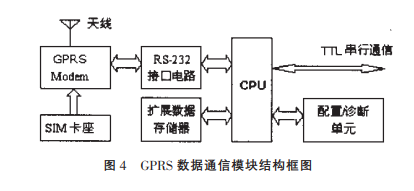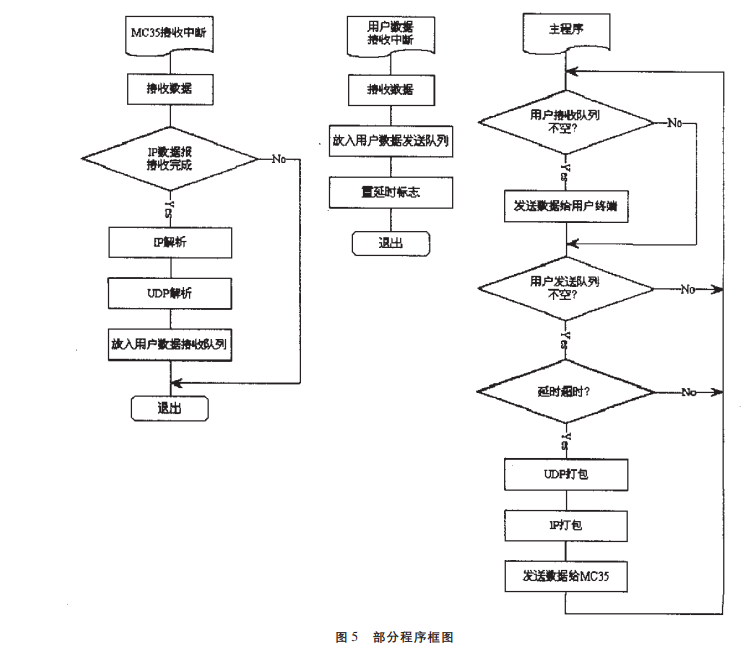This article will describe the wireless communication module principles of several common networks and what network architecture they are based on. This article will not include parameters. If you need to know more about various types of networks, you can check it out on Baidu!
GPRS wireless communication module principle
(1) Implementation of GPRS communication
To realize GPRS communication between user terminals and hosts connected to the Internet, they need to use the same protocol (i.e. TCP/IP) and work at the same network level. Considering the characteristics of embedded systems, the author adopts IP UDP protocol with low system overhead is used to implement GPRS communication. The UDP datagram sent by the host is transmitted to the GPRS communication module through the GPRS channel. The GPRS communication module is responsible for parsing the datagram. The parsed data is serially transmitted to the user terminal according to a certain baud rate. The data decomposition process (DemuItipIy) is shown in Figure 3.

(2) Overall structure
The embedded GPRS wireless communication module mainly consists of CPU, GPRS Modem, SIM card holder, configuration/diagnosis unit, TTL serial communication interface, extended data memory and other parts. Its structural block diagram is shown in Figure 4.

In the embedded GPRS wireless communication module, the GPRS Modem uses the MC35 GPRS wireless module of the German SIEMENS company. MC35 is embedded with two protocol stacks: PAP (Password Authentication ProtocoI) and CHAP (ChaIIengeHandshake Authentication ProtocoI) for PPP (Point-to-Point ProtocoI) to connect to the GPRS network. When the PPP connection is established, MC35 can follow the GPRS network The protocol sends and receives GPRS packet datagrams and parses and outputs IP datagrams [1]. MC35 provides a standard AT command interface and an RS-232 interface for connection with external application systems [2]. In addition, a SIM card interface is provided for connecting the SIM card holder to connect to different GPRS operating networks.
The CPU of the embedded GPRS wireless communication module adopts the W77E58 microcontroller chip of Taiwan Winbond Company [6]. The author has embedded IP and UDP protocol stack programs in the 32K program memory inside W77E58, which is used for the analysis and processing of IP and UDP datagrams. Pack. W77E58 provides two full-duplex UARTs. UART1 is connected to MC35 through the RS-232 level conversion circuit to send and receive IP datagrams; UART2 is used to connect to the user terminal. Pre-set UART can be applied between the user terminal and the embedded GPRS wireless communication module. Set the baud rate for serial communication.
In addition, a configuration/diagnosis unit is also designed in the module. The configuration/diagnosis unit follows the Xmodem protocol and can be easily connected to the COM port of the computer. Through the configuration/diagnosis unit, users can easily set the GGSN gateway address, host network SOCKS socket (IP address and port number), local port number (static IP addresses are not supported in the GPRS service provided by China Mobile Communications, all The IP address of the GPRS communication device is provided dynamically), the communication baud rate between the module and the user terminal and other information.
(3) Software design
The data reception of MC35 and the reception of user terminal data are implemented by interrupts. Two FIFOs are designed in the extended memory to temporarily store user terminal data. The data sent by the user terminal to the communication module will not be sent immediately because network transmission protocols such as IP and UDP will append a considerable amount of datagram information to the beginning and end of the user data [4]. Based on communication efficiency considerations, delay is used Factor method is used to decide whether to send data, that is, after receiving a user terminal data, if the next data is not received within a certain period of time, the data will be sent immediately; otherwise, it will be sent after a certain amount of data is received. The development of this software (including the IP/UDP protocol stack [5]) is designed and implemented using the KeiI C51 v6.22 software development kit of the German KeiI company. Part of the program block diagram is shown in Figure 5.

The following 2 communication modules are introduced simply.
So funktioniert das 4G-Modul
4G module refers to a general term for a product whose hardware is loaded into a designated frequency band, whose software supports the standardized LTE protocol, and whose software and hardware are highly integrated and modular. It has the characteristics of fast communication speed, wide network spectrum, and sensitive communication. The hardware integrates radio frequency and baseband on a small PCB board to complete wireless reception, transmission, and baseband signal processing functions. The software supports voice dialing, text message sending and receiving, dial-up networking and other functions. The 4G module transmits all terminal business data and normal operating status of the equipment to the business center in real time through high-speed networking. Through the management and monitoring platform, the operating status of the terminal equipment is monitored in real time and equipment faults can be checked in a timely manner. Efficiency has been greatly improved in many aspects such as operating costs, operation planning, and service timeliness.

How the WiFi module works
The Wi-Fi module is also called the serial Wi-Fi module. It belongs to the IoT transmission layer. Its function is to convert the serial port or TTL level into an embedded module that complies with the Wi-Fi wireless network communication standard. It has a built-in wireless network protocol IEEE802.11b.gn protocol stack and TCP/IP protocol stack. Traditional hardware devices embedded with Wi-Fi modules can directly use Wi-Fi to connect to the Internet, which is an important part of completing the use of wireless smart homes, M2M and other Internet of Things.
The WiFi module performs fast networking by specifying channel numbers. In the normal wireless networking process, all current channels will be automatically scanned to find the (or Adhoc) network established by the intended AP to be connected. The serial wifi module provides parameters for setting the working channel. Under the premise that the intended network address channel is known, the working channel of the module can be directly specified, thereby achieving the purpose of accelerating the networking speed.
Wireless communication module application prospects
The embedded GPRS wireless communication module relies on the wireless communication network of mobile communication operators to form a virtual dedicated data network to transmit user data. It has wide network coverage, reliable transmission, good scalability, flexible networking, fast construction cycle, and operation Low cost and other advantages. The construction cost of the system is also extremely low. The central station only needs to add an interface server and communication data line, and the terminal station only needs to add an embedded GPRS wireless communication module to form a complete data collection and control system. In addition, the embedded GPRS wireless communication module adopts transparent data transmission and protocol conversion, which facilitates users to carry out secondary development and apply it to different systems.
Keywords in this article: DTU, analog module